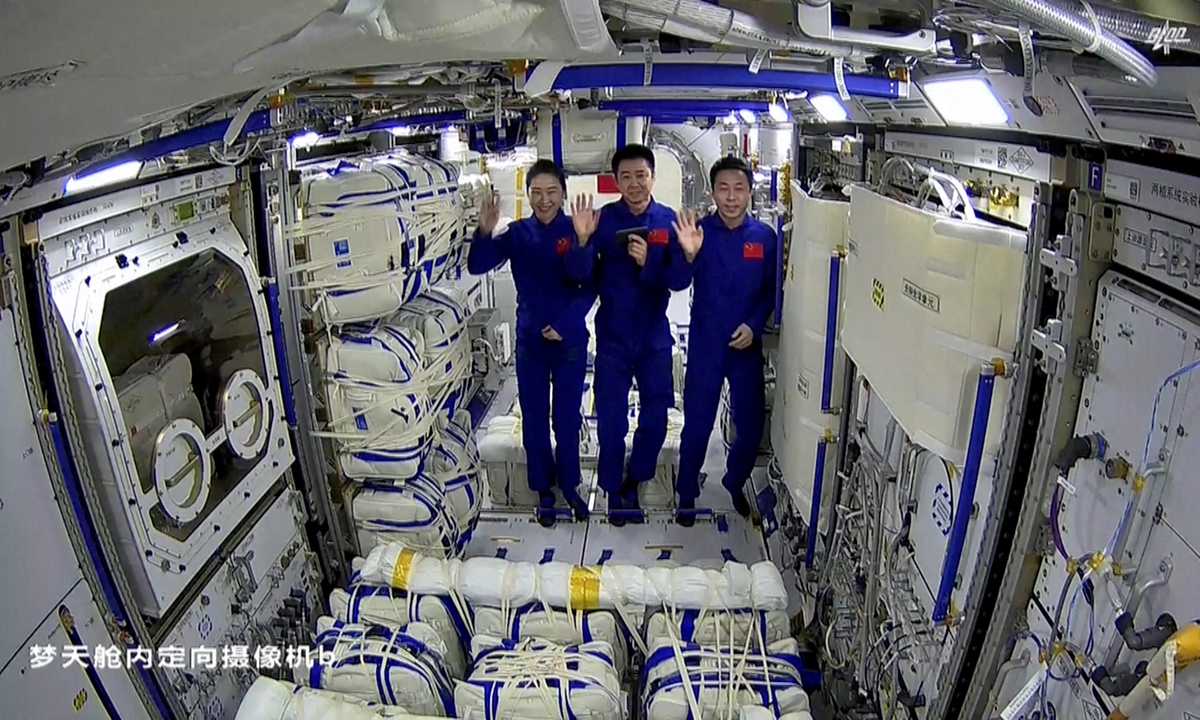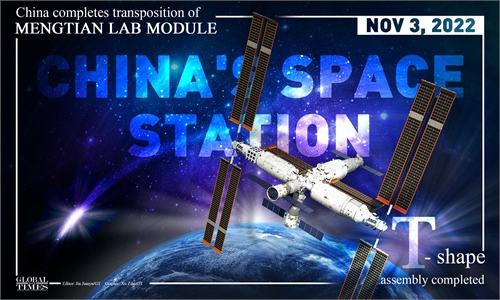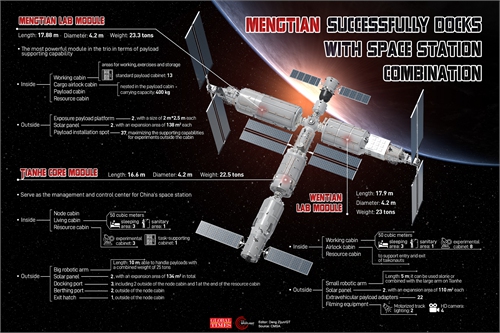Shenzhou-14 taikonauts enter Mengtian lab module after China Space Station completes assembly in orbit

The Shenzhou-14 taikonauts entered the Mengtian lab module - the third and last part of the three-module China Space Station - on November 3, 2022. Photo: IC
China's manned space program has witnessed another milestone, as the Shenzhou-14 taikonauts entered the Mengtian lab module - the third and last part of the three-module China Space Station - on Thursday afternoon, after the new module carried out a transposition to the side docking port, completing in-orbit assembly of the station's T-shape basic structure.
As seen on live coverage aired by state broadcaster China Central Television (CCTV) on Thursday, Shenzhou-14 mission commander Chen Dong first entered the Mengtian lab module, followed by his fellow crewmembers Liu Yang and Cai Xuzhe.
Chen announced that "the dream of Tiangong (celestial palace) has come true. The Shenzhou-14 crew has successfully entered the Mengtian lab module."
Liu, for her part, stressed that the "China Space Station is the common space home for humanity." Cai said "Let's embark on a new space journey together."
Chen told CCTV during a live space-ground link that on the 152nd day of their space journey, the crew finally welcomed the Mengtian module. "Our space home has now become more spacious."
The Shenzhou-14 crew, in their five-month stay in space, has carried out two spacewalks, delivered one Tiangong Classroom lecture session and received two of the three modules of the space station in space.
According to the China Manned Space Agency (CMSA), the Shenzhou-14 crew will be visited by the Tianzhou-5 cargo spacecraft and the Shenzhou-15 manned spacecraft, and two crews of six taikonauts will make China's first direct handover in-orbit.
During the transposition maneuver earlier on Thursday, the Mengtian lab module first completed its state configuration and separated from the space station's core module, the Tianhe. Later, the Wentian conducted its transposition and then docked with the side port of the space station's node cabin. The Mengtian transposition took about one hour, the Global Times learned from the CMSA on Thursday.
With the successful transposition operation of the Mengtian lab module, the China Space Station has completed the assembly of its T-shape basic structure in orbit, marking a key step forward toward the completion of the space station.
Next, tests and assessment work will be carried out on the basic functions of the China Space Station, said the CMSA in a statement it provided to the Global Times.
It was the second time that China has completed an in-orbit transposition of a large-scale spacecraft cabin by applying transfer facilities, following a first with the Mengtian - the first space station lab on September 30.
After the two transpositions, the space station combination has formed the T-shape basic structure with the Tianhe core module in the middle, with the Wentian and Mengtian on the side and symmetric to each other.
"Only when the three modules complete their assembly and form the T-shape structure in orbit, can we declare that we have achieved all preset goals. Only when they complete the T-shape basic structure, can the power supply, information and thermal control systems deliver their best performances and support relatively larger experiments," Bai Linhou, deputy chief designer from the space station system at the China Academy of Spacecraft Technology (CAST), told the Global Times.
The T-shape basic structure of the China Space Station with all module cabins on the same plane, could greatly increase the supporting capabilities for the application payload on board, Wu Jun, chief designer of the Mengtian lab module with the Shanghai Academy of Spacecraft Technology (SAST), told the Global Times.
The symmetrical T-shape design could also be the center of mass for the China Space Station, to be well-placed in the middle of the combination, which would reduce both the difficulty and energy consumption of flight control, Pang Zhihao, a Beijing-based space expert, told the Global Times on Thursday.
The T-shape design is of great safety value, Pang said. The two airlock cabins are located at the far ends of the combination and on the same plane, so events like a normal pressure relief or an abnormal isolation at one end would not affect the space inside other cabins.
The T-shape design would also enable the giant solar panels installed at the ends of the two lab modules to face the Sun, regardless of the flight attitude of the space station, Pang added.
Just like the Wentian lab module, the Mengtian took the power solution into consideration to prepare for more demanding in-orbit experiments. The Mengtian is also equipped with giant flexible solar panels, each of which can extend some 138 square meters. Both the Wentian and Mengtian cabins are equipped with Sun orientation devices and driving mechanisms.
With the combined motion of two degrees of freedom, the pairs of solar wings on the two lab modules would rotate synchronously, ensuring that they face the Sun like sunflowers all the way in the China Space Station's flight in orbit.
After the completion of the T-shape China Space Station, two pairs of such solar panels on the Wentian and Mengtian modules could together generate nearly 1,000 kilowatt hours of electricity per day, equivalent to the half-year consumption of a household.
According to the SAST, this means that the space station needn't worry about electricity.
According to CCTV on Thursday, the third batch of taikonauts, including 17 men and one woman, are expected to begin executing space station missions starting from 2023. The third batch of taikonauts has seven space pilots, seven flight engineers and four payload experts.
China has started the selection process for the fourth batch of taikonauts to join future missions, the CMSA disclosed in early October.
Twelve to 14 candidates are expected to be chosen, including seven or eight pilots. Engineers as well as payload experts will also be selected to join the force, the CMSA said. The posts of payload experts are also open to applicants from the Hong Kong and Macao special administrative regions for the first time.



